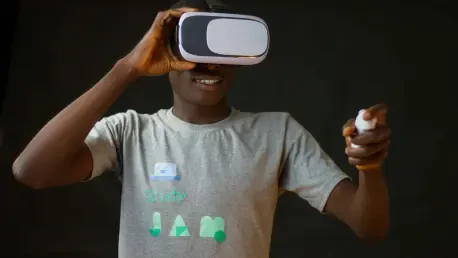In a world where augmented reality (AR) technology has often been confined to niche markets due to exorbitant costs and limited practicality, Meta’s latest venture into smart eyewear is generating significant buzz. The company’s upcoming release of the Hypernova smart glasses, priced at an accessible $800, signals a bold attempt to bridge the gap between cutting-edge innovation and everyday usability. Unlike high-end mixed reality headsets that can cost thousands, this product targets a broader audience, aiming to integrate AR into daily life. With a launch slated for September, Meta is positioning itself as a frontrunner in making AR not just a futuristic concept, but a tangible part of consumer tech. This move raises intriguing questions about whether affordability and strategic design can finally push AR beyond early adopters into the mainstream market, challenging the barriers that have long hindered widespread adoption.
Unveiling the Hypernova Innovation
Design and Features Driving Accessibility
Meta’s Hypernova smart glasses stand out with a design that prioritizes practicality over extravagance, a decision that could redefine consumer expectations for AR devices. Priced at $800—a significant drop from earlier speculations of $1,000 or more—these glasses feature a monocular digital display on the right lens, capable of showing notifications and text messages. This choice, as highlighted by Meta’s technology chief, balances cost efficiency with functional visual interaction, avoiding the complexities of a binocular setup. Additionally, the inclusion of an sEMG wristband controller, powered by neural technology from Meta’s CTRL Labs, introduces gesture-based controls that adapt to user inputs through machine learning. This innovative accessory hints at the potential for more immersive AR experiences in future iterations, even if the current 20-degree field of view remains limited. By focusing on essential features, Meta seems determined to offer a product that feels like a natural extension of everyday eyewear rather than an unwieldy gadget.
The strategic partnership with Luxottica, a titan in the eyewear industry, further enhances the Hypernova’s appeal by merging tech with style. This collaboration ensures that the glasses don’t just function as a device but also fit seamlessly into daily fashion. Beyond aesthetics, the partnership has already proven its worth with impressive sales of earlier smart glasses models, setting a strong foundation for the Hypernova’s market entry. The focus on a single-lens display also addresses power and weight concerns, making the glasses more comfortable for prolonged use. While this design choice might not satisfy enthusiasts craving expansive AR capabilities, it reflects a calculated effort to appeal to casual users who value simplicity and affordability. This approach could be the key to unlocking a wider demographic, positioning the Hypernova as a transitional step toward more advanced AR systems while still delivering meaningful utility in its current form.
Balancing Cost and Technological Ambition
The $800 price tag of the Hypernova glasses isn’t just a number; it’s a statement of intent in an industry where AR and mixed reality devices often carry prohibitive costs. Meta’s decision to accept lower margins mirrors a broader trend among tech giants aiming to scale user bases rather than maximize immediate profits. This pricing strategy directly challenges the notion that AR must remain a luxury, offering an entry point for consumers hesitant to invest in pricier alternatives like mixed reality headsets. By keeping costs down, Meta hopes to drive adoption and build momentum in a market that has struggled with consumer skepticism. The Hypernova’s limited field of view and basic functionalities underscore this pragmatic approach, ensuring that the device remains within reach for a diverse audience while still hinting at the possibilities of future upgrades.
Moreover, the emphasis on iterative progress is evident in Meta’s simultaneous unveiling of a third-generation voice-only smart glasses model with touch controls at its Connect event. This dual release strategy showcases a commitment to catering to varied consumer needs, from those seeking minimalistic tech to others ready for visual AR interactions. The Hypernova’s reliance on a customized Android system, without a dedicated app store, further streamlines costs by focusing on core features accessible via the wristband and gestures. While this might disappoint tech purists expecting a fully fleshed-out ecosystem, it aligns with Meta’s goal of testing the waters with accessible innovation. The real test lies in whether these glasses can prove their worth as practical tools, not just novelties, in the hands of everyday users—a hurdle that could determine their role in shaping AR’s trajectory.
Strategic Moves and Market Impact
Leveraging Partnerships for Market Reach
Meta’s alliance with Luxottica emerges as a cornerstone of its strategy to dominate the smart glasses arena, blending technological prowess with established eyewear expertise. Since their collaboration began, Luxottica has sold millions of earlier smart glasses models, contributing to a staggering 300% year-over-year revenue increase in this category. A recent agreement granting Meta a 3% stake in Luxottica and exclusive rights to several of its brands further cements this partnership, enhancing production and distribution capabilities. This synergy not only boosts Meta’s ability to scale but also ensures that the Hypernova glasses resonate with consumers as stylish, everyday accessories rather than niche tech. Such integration is vital for shifting public perception, making smart glasses a normalized part of life rather than a futuristic oddity.
Beyond sales figures, this partnership reflects a deeper ambition to redefine wearable tech through trusted design and branding. Luxottica’s expertise in crafting appealing eyewear allows Meta to focus on embedding innovative features without sacrificing wearability or aesthetic appeal. The Hypernova’s potential to become a daily-use item hinges on this balance, as consumers are more likely to embrace tech that doesn’t feel like a compromise in style or comfort. Additionally, the collaboration provides Meta with a competitive edge in a crowded market, where differentiation through design can be as crucial as technological advancements. If successful, this model of cooperation could set a precedent for how tech companies approach consumer-facing AR products, prioritizing partnerships that amplify both innovation and accessibility over standalone development.
Navigating Competitive Pressures and Developer Engagement
In a landscape where mixed reality devices have often faltered due to high costs and limited appeal, Meta’s Hypernova glasses represent a calculated pivot toward accessibility as a competitive advantage. The broader market has seen sluggish consumer adoption, with expensive headsets struggling to justify their price tags for casual users. By contrast, Meta’s $800 offering aims to lower the barrier to entry, targeting a demographic eager for practical tech without the financial burden. This pricing strategy isn’t just about undercutting rivals; it’s about building a critical mass of users who can drive demand and validate AR’s relevance in daily scenarios. The success of this approach will depend on whether the Hypernova can carve out a unique space as an indispensable tool rather than a fleeting trend.
Equally significant is Meta’s push to engage developers, even as the Hypernova operates on a simplified platform without a dedicated app store. By inviting developers to test the device and its accessories like the sEMG wristband, Meta is laying the groundwork for a future ecosystem that could support richer AR experiences. This outreach signals a long-term vision of fostering innovation around its hardware, even if the current model focuses on basic functionalities like notifications. Exploring emerging technologies such as generative AI for the platform also hints at ambitious plans to expand capabilities over time. While immediate expectations for the Hypernova remain grounded, this developer focus could accelerate the evolution of Meta’s AR offerings, positioning the company to adapt swiftly to market feedback and technological breakthroughs in the coming years.
Reflecting on a Pivotal Step Forward
Looking back, Meta’s launch of the Hypernova smart glasses marked a deliberate stride toward democratizing AR through a blend of affordability, practical design, and strategic alliances. The $800 price point, coupled with a functional yet restrained feature set, positioned the device as a bridge between rudimentary smart glasses and the promise of full AR systems. Partnerships like the one with Luxottica played a crucial role in ensuring market reach and consumer appeal, while efforts to engage developers hinted at a broader vision for the technology’s future. As the dust settled on this release, the true measure of success rested on whether these glasses became a staple in daily life or remained a curiosity. Moving forward, stakeholders could look to refine user experiences, expand ecosystem support, and monitor market responses to shape the next wave of AR innovations, ensuring that accessibility remained at the heart of this evolving journey.









